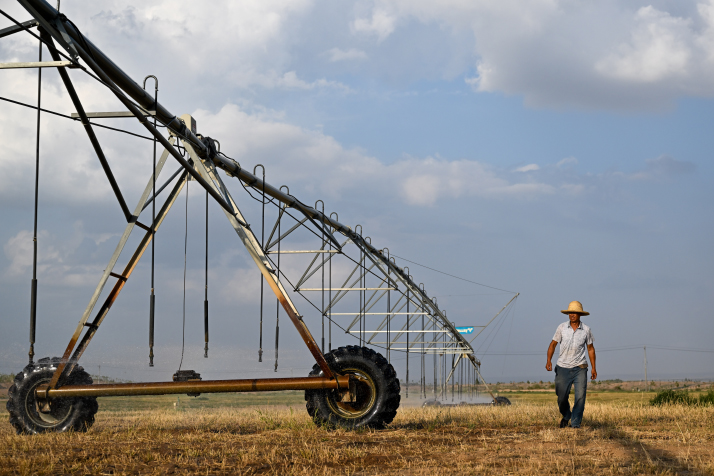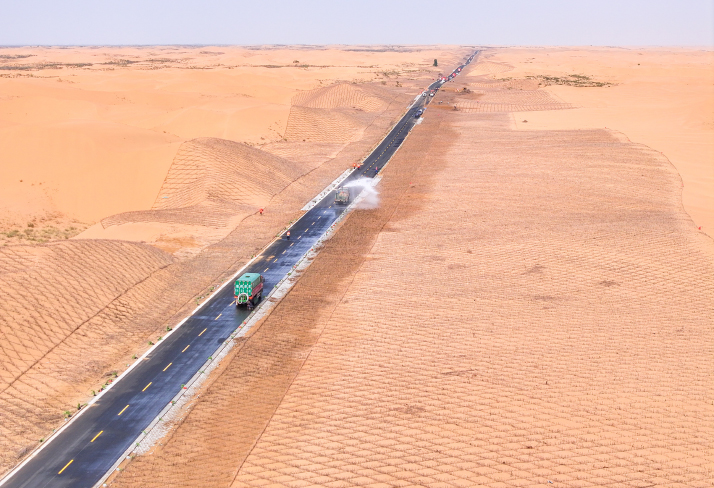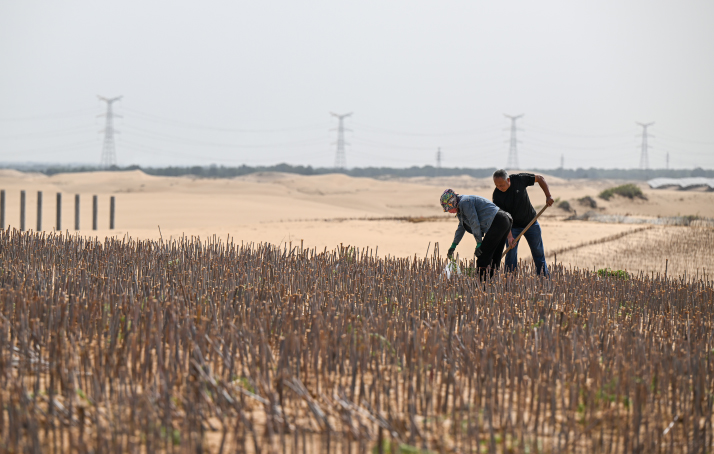| China |
| Where desert meets river | |
|
|
 The ecological restoration project area of yanwangbizi section of the Yellow River in Alxa League on August 1 (XINHUA)
Where the Yellow River brushes against the shifting edge of the Ulan Buh Desert in Inner Mongolia Autonomous Region, there is a place the locals call yanwangbizi, literally translated as the "King of Hell's nose," meaning it was as dangerous as the entrance to hell. Centuries ago, the stretch was a vital hub on the ancient Camel Salt Road, a trade route dating back more than 2,000 years. But the journey along the road was treacherous. Camel caravans transporting salt and other goods faced sandstorms and sudden riverbank collapses, with dunes tumbling into the river without warning and swallowing merchants and their laden camels. Over time, silt from the desert built up here, forming a nose-shaped spit—that earned the place its name. Bend greening The Yellow River is known as China's "mother river" and the cradle of Chinese civilization. For countless generations, it has given life to its basin and nurtured a wealth of culture. Yet it also brought destruction. For those who live beside it, feelings toward the river have always been a mix of deep affection and wary respect—a relationship constantly negotiated, especially in desert regions. As the river flows into its middle reaches, it forms meandering bends, within which lies yanwangbizi. The areas near the bends, with their complex of plateaus, mountains and deserts, are both a major origin of the sandstorms that sweep east across China and the primary source of sediment feeding the river's middle and lower reaches that brings much needed fertility to the downstream plains but that can also raise the riverbed and heighten the risk of flooding. Controlling desertification around the bends is therefore critical to maintaining the river's peaceful flow—an enduring effort for the communities along its banks. Zhao Hongyan grew up in a herding area of Inner Mongolia not far from the Yellow River. In the early 1990s, responding to the national call to combat desertification, Zhao's father left herding for farming and began taking part in desert control work, earning extra income to help with household expenses. Zhao remembers how, after work, his father would come home too tired to talk. "He rarely spoke to us," Zhao told Beijing Review. "Life during my childhood was tough and monotonous. We stayed by the desert and the river, living by the rhythm of sunrise and sunset. It gave me a quiet sense of inferiority." In 1978, China launched the Three-North Shelterbelt Forest Program, one of the world's largest ecological initiatives, aimed at combating desertification in north, northwest and northeast China. Scheduled to run in eight phases until 2050, it is now in its sixth phase (2021-30). In June 2023, President Xi Jinping called for a 10-year campaign to accelerate the shelterbelt program. He emphasized the need to prioritize key areas and launch three landmark initiatives in areas near the meandering bends of the Yellow River, the Horqin and Hunshandake sandy lands in Inner Mongolia, and further west, the Hexi Corridor-Taklimakan Desert region. The Hexi Corridor in Gansu Province is a critical part of the ancient Silk Road, and the Taklimakan Desert in Xinjiang Uygur Autonomous Region is China's largest desert, once known as the "sea of death." Zhao also joins the ranks of the fight against desertification. He now serves as chairman of Alxa Binhe Jinsha Development Co. Ltd., a state-owned enterprise responsible for the sand-blocking and ecological restoration project in yanwangbizi—a key step in the efforts to combat desertification around the bends.  A technician inspects irrigation equipment at the ecological restoration project area of the yanwangbizi section of the Yellow River in Alxa League, Inner Mongolia Autonomous Region, on August 1 (XINHUA)
The project involved two processes: first stabilizing the sand with straw grids, then planting trees, shrubs and grasses to create three protective forest belts. These belts can slow surface winds and help keep the sand in place. "The work was especially challenging," Gong Hongbin, a frontline worker on the project, told Beijing Review. "In the early stage, a single night of wind could undo a full day's leveling work." Planting trees directly in the sand didn't work, so the workers had to lay straw grids and build windbreaks to hold the dunes, then brace each tree. "Despite these efforts, strong winds and rainstorms killed many seedlings, and we had to replant at least three times before achieving today's results," Gong said. The two-year project, covering about 733 hectares, was completed in April 2024. As a result, vegetation cover has risen from under 5 percent to more than 35 percent, and the annual amount of sand and silt entering the Yellow River from this area has dropped by 90,000 tons. Ten great gullies In 1996, 21-year-old Wang Lijun graduated from a water conservancy school and joined the fight against desertification in Dalad Banner, Ordos, Inner Mongolia. A banner is a county-level administrative division under a league, which is a prefecture-level division, in Inner Mongolia. "At that time, we had more than 20 sandstorms a year. When they hit, the sky went dark, and even at noon you could see nothing indoors without switching the lights on," he told Beijing Review. Now, in the land where he has worked for 30 years, the rippling surface of the winding river reflects blue skies and white clouds, with waterbirds gliding past. In Dalad Banner, 10 tributaries empty into the northernmost section of the meandering bends of the Yellow River from east to west. They are seasonal flood gullies, known in Mongolian as kongdui—a well-known landscape of the areas near the bends. A banner is a county-level administrative division in Inner Mongolia. The entire gully region is dry most of the year, with over half its rainfall coming in July and August, often as torrential downpours. These storms cause short and intense floods carrying large amounts of sand and silt. The floodwaters bring sediment from the hills and desert into the Yellow River. Each year, it adds an average of 27.11 million tons of sediment, roughly one 10th of the river's national total, raising water levels and bursting banks, threatening nearby communities. Since the 1950s, sediment from the gullies has blocked the mother river eight times. Wang said efforts to manage the gullies began long before he arrived. A local soil and water conservation station was established in 1956. Now serving as head of the Soil and Water Conservation Office at the Dalad Banner Water Resources Bureau, Wang has seen the work evolve from manual, small-scale measures to comprehensive restoration. Since 2022, the annual government budget for each gully's management has remained around 100 million yuan ($14 million), with supporting private investment steadily growing, according to him. The gullies' watershed spans 10,800 square km, with restoration strategies tailored to the unique landforms and natural conditions of each zone. Wang said an integrated model is used in the upper reaches, consisting of planting trees on mountain tops, planting grass on the slopes, building terraces along the hillsides and constructing silt dams in gully bottoms. In the middle reaches, across the Kubuqi Desert, trees, shrubs and grasses are planted in the south to block sandstorms; edge-locking forest belts are built in the north along the Yellow River to stop sand from entering the water; and in the center, the desert is segmented for control through the building of roads that cut across the dunes.  A road cuts through the desert in Dalad Banner, Inner Mongolia, on May 20 (XINHUA)
Building roads through the desert has become an important sand-control method in Dalad Banner. Qu Ran, Deputy Director of the Transport Bureau, said establishing edge-protection forest belts and adding photovoltaic panels along both sides of the roads help fix the sand. This not only restores the ecology but also increases solar power generation and makes travel easier for local residents and tourists. To date, Dalad Banner has built a desert-crossing network of three east-west and six north-south roads, totaling 544 km, with 185 km of additional roads to be built by 2030. In the lower reaches, measures such as building grass belts and installing artificial sand barriers are being adopted to reinforce the banks. Wang also emphasized the efficacy of water management projects in channeling sediment- and nutrient-rich floodwaters into the Kubuqi Desert to develop high-quality farmland. This is a distinctive feature of sand-control initiatives in the gully region. With multiple management models working in tandem, the annual average sediment discharge to the Yellow River from the 10 gullies has dropped greatly, while the soil and water conservation ratio, the proportion of the region that is not subject to water and soil loss, has risen year by year, reaching 59.39 percent in 2025.  Tree-planting workers place saplings within straw grids to combat desertification in Dalate Banner, Ordos, Inner Mongolia, on May 20 (XINHUA)
Anti-desertification plus Over the years, China's efforts to combat desertification have grown beyond simply stopping the sand. They have given rise to multiple related industries. Photovoltaic sand control is one of them. From above Ordos, on the southern bank of the Yellow River and along the northern edge of the Kubuqi Desert, the "great wall of photovoltaics" stretches nearly 400 km from east to west, playing the dual role of desertification control as well as solar and wind power generation. "Solar panels can block wind and sunlight, protecting the plants growing beneath them," Li Kai, Director of the Comprehensive Energy Support Center of the Dalad Banner Energy Bureau, told Beijing Review. "This approach reduces evaporation, helps roots take hold and improves soil conditions." The water used for irrigation comes from treated drainage water produced during local coal mining, turning waste into a valuable resource, Li said. At present, the photovoltaic sand control belt in the Kubuqi Desert has been completed with an installed capacity of 10.02 million kilowatts, achieving sand control over 46,700 hectares. "The plants growing beneath the panels were carefully selected," Hong Guangyu, a senior researcher at the Inner Mongolia Academy of Forestry, told Beijing Review. In the past, only a single species was planted, leaving the ecosystem fragile and prone to large-scale decline when extreme weather struck. Now, with years of research, scientists have improved seed selection, introduced new varieties and improved planting techniques, Hong said. Under the combined effects of multiple species, vegetation is now more resilient to natural disasters, with greater ecological as well as economic value. For example, some species enrich the soil and provide forage, while others can be grafted with high-value medicinal plants such as desert ginseng (Cistanche deserticola), which requires a host plant, bringing direct benefits to local communities, she added. In Alxa Left Banner, Alxa League, a forest of saxaul trees has become both a shield against sand and a source of income. The trees protect the Yellow River and are the host of desert ginseng. Out of a planned area of more than 66,000 hectares, more than 28,600 hectares have been planted since 2012, grafted with more than 3,800 hectares of desert ginseng. The annual fresh ginseng yield is about 300 tons, worth nearly 6 million yuan ($837,000). Local policy encourages farmers and herders to take part in ecological initiatives, either by working on them for wages or by investing in them. "At first, people weren't interested due to uncertain profitability," said Wang Zhongning, Secretary of the Communist Party of China (CPC) Manglai Gacha (Village) Branch. "When we asked villagers to plant trees and desert ginseng on their land, none were interested. Sometimes we had to visit a family four or five times, and they still refused. But after two or three years, when they saw the trees survive, they came to us asking to plant more." Dengkou County in Bayannur City lies beside both the Ulan Buh Desert and the meandering bends of the Yellow River. Once part of the Yellow River's ancient course, the area is dotted with more than 100 small lakes, giving it abundant water resources. Combined with long hours of sunshine, it is well suited to developing desert-based industries. In addition to desert ginseng and specialty fruits, the region is particularly favorable for growing high-quality pasture. In recent years, it has built a dairy industry chain that integrates pasture development, dairy farming and dairy product processing, while also developing ecotourism, including by establishing wetland parks. For 70 years, Dengkou has battled the desert, pushing back its eastern edge by 15 km. "At first, efforts were reactive, driven by the need to survive in a harsh environment that threatened to engulf homes, and with them, our mother river," Han Yinglian, Secretary of the CPC Committee of the Dengkou County Bureau of Desertification Prevention, told Beijing Review. "Over time, however, by combining desert control with local industries, we shifted to proactive restoration, seeking more projects and bringing in private investment." Zhao, the entrepreneur, said after decades of efforts, local people have moved from fearing the sand, to resisting it, to controlling it, and now to making use of it. "The deserts and the Yellow River have become our resources," Zhao said. "People can truly reap the benefits of transforming deserts turn into oases. Our sense of belonging and pride in this land has grown stronger, and our hometown has become a place others admire." Copyedited by G.P. Wilson Comments to zhangshsh@cicgamericas.com |
|
||||||||||||||||||||||||||||
|